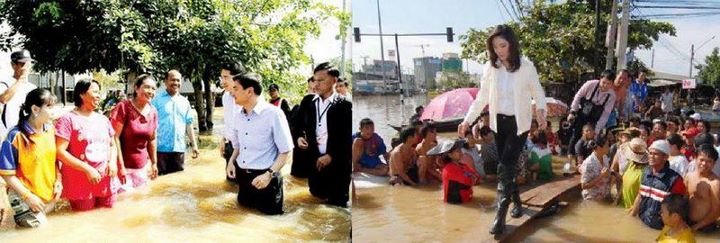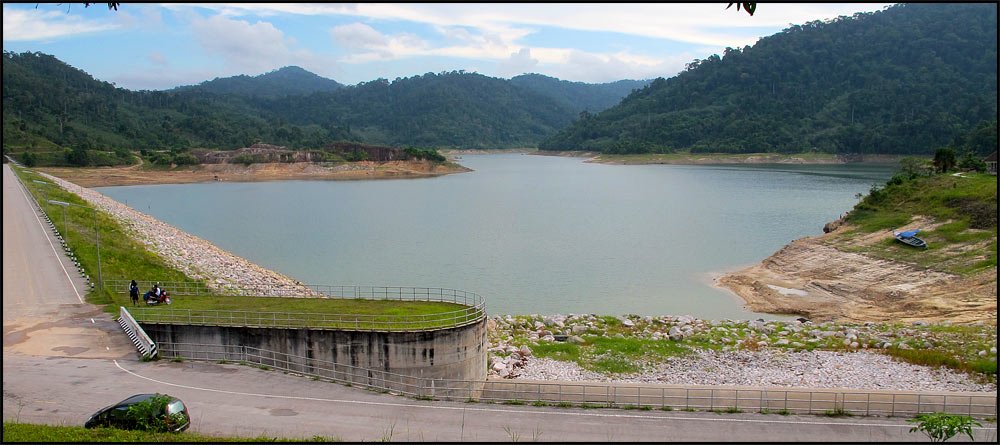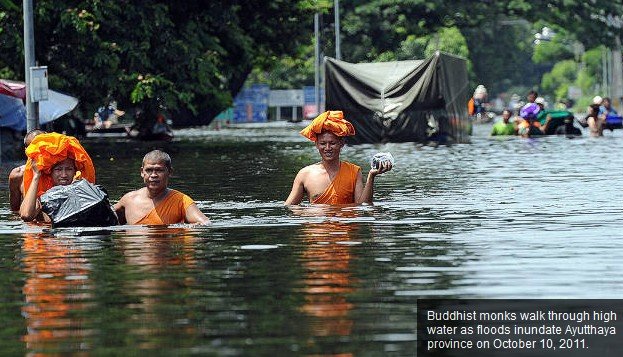KTMphil
Senior member
Thailand Floods Reach Crisis Level, Threaten Bangkok, Prime Minister Says
Thailand’s worst floods in more than half a century have reached a “crisis level” and threaten to swamp the capital, Bangkok, as early as next week, Prime Minister Yingluck Shinawatra said.
“This will have a direct impact on Bangkok,” Yingluck said late yesterday in a nationally televised address. “We have to admit that this is more serious than in the past.”
At least 252 people have been killed and millions more displaced over the past two months as seasonal monsoon rains spread across 59 of Thailand’s 77 provinces, Yingluck said. She said her two-month-old administration is struggling to respond to the crisis as the nation’s largest dams approach their capacity and floodwaters threaten factories operated by Honda Motor Co. and Sony Corp.
“The government is just a little more than a month old and it is difficult to cope with this situation because the volume of water is exceptionally high,” Yingluck said.
Bangkok is prone to seasonal flooding because much of the city of more than 6 million people sits less than 2 meters above sea level. Yingluck said flooding in the capital may be worse than in 1995, when a deluge caused almost 12 billion baht ($388 million) of damage, according to government estimates.
Nationwide losses from this year’s floods may reach 130 billion baht and reduce economic growth by as much as 1.3 percentage points, the University of the Thai Chamber of Commerce, a private institution established by the chamber, said on Oct. 6.
Damage Bill
The government estimates the most recent floods have already caused as much as 30 billion baht of damage, Deputy Prime Minister Kittiratt Na-Ranong said on Oct. 5, describing the deluge as “the worst in 50 or 60 years.”
The disaster has affected more than six million people in Southeast Asia and claimed a further 224 lives in Cambodia, Vietnam and the Philippines, according to the United Nations. Thailand has seen the most fatalities as typhoons and above- average rainfall damage crops, destroy businesses and uproot families.
As many as 7 billion cubic meters of water is flowing toward Bangkok from Thailand’s northern provinces, Yingluck said, threatening to overwhelm flood defenses on the Chao Phraya river that runs through the capital
“There will be damage in a wide area” in provinces north of Bangkok, including Nakhon Sawan and Ayutthaya, Yingluck said. Typhoon Nalgae, which buffeted the Philippines last week and has since weakened into a tropical depression, may bring more rain to Thailand over the next few days, pushing dams to their capacity, Yingluck said.
She said high tides expected between Oct. 15 and Oct. 17 may exacerbate flooding in the capital.
Drain Water
“Our urgent task now is to drain water out to sea before more water arrives,” Yingluck said. The government will set up a centralized flood-control center today to help coordinate disaster relief, she said.
Heavy rain has hit the country since July 25 and 28 provinces remain submerged, the Department of Disaster Prevention and Mitigation said on its website yesterday.
Industrial parks in Ayutthaya province are at risk after floods caused nearby plants to shut down, and road and rails links between Bangkok and Thailand’s northern provinces have been severed by floodwaters.
“The situation in Ayutthaya is quite worrisome,” Yingluck said after surveying the damage by helicopter two days ago. “In some areas water has reached levels we have never seen before.”
Flooded Factories
More than a hundred factories producing auto parts, food and electronics have temporarily closed, according to the Federation of Thai Industries. Plants operated by Danish shoemaker ECCO Sko A/S and Japanese food and beverage producer Ajinomoto Co. are among 40 factories in Ayutthaya that have shut down, Narapote Thewtanom, deputy governor of the Industrial Estate Authority Thailand, said this week.
Canon Inc. halted operations at its inkjet printer plant in Ayutthaya because of flooding and will keep the factory closed as a precautionary measure, Hirotomo Fujimori, a Tokyo-based spokesman for the company, said by phone on Oct. 6. Indorama Ventures Pcl (IVL), which says it’s the world’s largest producer of polyester, shut factories in Lopburi province that make wool yarns and polymers, the company said on Sept. 27.
Sony Corp.’s factory in Ayutthaya, which produces digital cameras and lenses, hasn’t suffered major damage from flooding and is operating as normal, Yasuhiro Okada, a Tokyo-based spokesman for the electronics maker, said earlier this week.
Honda Shutdown
Honda, Japan’s third-largest automaker, halted output at a plant in Ayutthaya that can produce 240,000 vehicles a year after floods caused supply shortages, Pitak Pruittisarikorn, executive vice president of its Thai unit, said on Oct. 6.
Honda’s plant is located in Rojana Industrial Park, which is mostly a base for companies making automotive and electronics parts. Nikon Corp., Hitachi Metals Ltd. and Siam Cement Pcl are among companies with operations in the estate, according to Rojana’s website.
The deluge has displaced 2.6 million people in Thailand since late July and damaged almost 10 percent of rice farms in the biggest exporter of the grain, data from the Department of Disaster Prevention and Mitigation and the Ministry of Agriculture and Cooperatives show.
From Bloomberg news
Thailand’s worst floods in more than half a century have reached a “crisis level” and threaten to swamp the capital, Bangkok, as early as next week, Prime Minister Yingluck Shinawatra said.
“This will have a direct impact on Bangkok,” Yingluck said late yesterday in a nationally televised address. “We have to admit that this is more serious than in the past.”
At least 252 people have been killed and millions more displaced over the past two months as seasonal monsoon rains spread across 59 of Thailand’s 77 provinces, Yingluck said. She said her two-month-old administration is struggling to respond to the crisis as the nation’s largest dams approach their capacity and floodwaters threaten factories operated by Honda Motor Co. and Sony Corp.
“The government is just a little more than a month old and it is difficult to cope with this situation because the volume of water is exceptionally high,” Yingluck said.
Bangkok is prone to seasonal flooding because much of the city of more than 6 million people sits less than 2 meters above sea level. Yingluck said flooding in the capital may be worse than in 1995, when a deluge caused almost 12 billion baht ($388 million) of damage, according to government estimates.
Nationwide losses from this year’s floods may reach 130 billion baht and reduce economic growth by as much as 1.3 percentage points, the University of the Thai Chamber of Commerce, a private institution established by the chamber, said on Oct. 6.
Damage Bill
The government estimates the most recent floods have already caused as much as 30 billion baht of damage, Deputy Prime Minister Kittiratt Na-Ranong said on Oct. 5, describing the deluge as “the worst in 50 or 60 years.”
The disaster has affected more than six million people in Southeast Asia and claimed a further 224 lives in Cambodia, Vietnam and the Philippines, according to the United Nations. Thailand has seen the most fatalities as typhoons and above- average rainfall damage crops, destroy businesses and uproot families.
As many as 7 billion cubic meters of water is flowing toward Bangkok from Thailand’s northern provinces, Yingluck said, threatening to overwhelm flood defenses on the Chao Phraya river that runs through the capital
“There will be damage in a wide area” in provinces north of Bangkok, including Nakhon Sawan and Ayutthaya, Yingluck said. Typhoon Nalgae, which buffeted the Philippines last week and has since weakened into a tropical depression, may bring more rain to Thailand over the next few days, pushing dams to their capacity, Yingluck said.
She said high tides expected between Oct. 15 and Oct. 17 may exacerbate flooding in the capital.
Drain Water
“Our urgent task now is to drain water out to sea before more water arrives,” Yingluck said. The government will set up a centralized flood-control center today to help coordinate disaster relief, she said.
Heavy rain has hit the country since July 25 and 28 provinces remain submerged, the Department of Disaster Prevention and Mitigation said on its website yesterday.
Industrial parks in Ayutthaya province are at risk after floods caused nearby plants to shut down, and road and rails links between Bangkok and Thailand’s northern provinces have been severed by floodwaters.
“The situation in Ayutthaya is quite worrisome,” Yingluck said after surveying the damage by helicopter two days ago. “In some areas water has reached levels we have never seen before.”
Flooded Factories
More than a hundred factories producing auto parts, food and electronics have temporarily closed, according to the Federation of Thai Industries. Plants operated by Danish shoemaker ECCO Sko A/S and Japanese food and beverage producer Ajinomoto Co. are among 40 factories in Ayutthaya that have shut down, Narapote Thewtanom, deputy governor of the Industrial Estate Authority Thailand, said this week.
Canon Inc. halted operations at its inkjet printer plant in Ayutthaya because of flooding and will keep the factory closed as a precautionary measure, Hirotomo Fujimori, a Tokyo-based spokesman for the company, said by phone on Oct. 6. Indorama Ventures Pcl (IVL), which says it’s the world’s largest producer of polyester, shut factories in Lopburi province that make wool yarns and polymers, the company said on Sept. 27.
Sony Corp.’s factory in Ayutthaya, which produces digital cameras and lenses, hasn’t suffered major damage from flooding and is operating as normal, Yasuhiro Okada, a Tokyo-based spokesman for the electronics maker, said earlier this week.
Honda Shutdown
Honda, Japan’s third-largest automaker, halted output at a plant in Ayutthaya that can produce 240,000 vehicles a year after floods caused supply shortages, Pitak Pruittisarikorn, executive vice president of its Thai unit, said on Oct. 6.
Honda’s plant is located in Rojana Industrial Park, which is mostly a base for companies making automotive and electronics parts. Nikon Corp., Hitachi Metals Ltd. and Siam Cement Pcl are among companies with operations in the estate, according to Rojana’s website.
The deluge has displaced 2.6 million people in Thailand since late July and damaged almost 10 percent of rice farms in the biggest exporter of the grain, data from the Department of Disaster Prevention and Mitigation and the Ministry of Agriculture and Cooperatives show.
From Bloomberg news



































